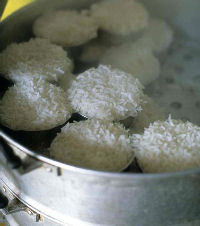The content of toxic arsenic in rice not only depends on wherefrom you get the rice but also how you serve it; that is the result of a new study performed by a UK research group.
Background:Rice is the only staple crop grown under flooded soil conditions. Under anaerobic conditions, arsenic in soil is converted readily to arsenite which is mobile, leading to arsenic in rice grain being around 10-fold higher than for other crops. Arsenic contamination of rice is further exacerbated when the soil or the irragation water is polluted with arsenic. Toxic inorganic arsenic, classified a non-threshold carcinogen, can constitute up to 90 % of the total arsenic present in rice.
The new study:Using arsenic speciation analysis, the research group from the University of Aberdeen, UK, investigated the question whether the cooking technique has an influence on the final content of toxic arsenic in the prepared rice meal.

Three different cooking procedures were investigated, a) low volume water (2.5 :1) cooking, b) high volume water (6:1) cooking and c) steaming. After cooking, the rice was dried and then either digested with H
2O
2/nitric acid or extracted with diluted (1%) H
2O
2/nitric acid in a microwave system.
Total arsenic concentrations were determined by ICP-MS using collision-cell technology. Arsenic species distribution was determined by HPLC coupled with the same ICP-MS instrument (Agilent 7500c).
The results indicated that rinse washing was effective at removing circa. 10% of the total and inorganic arsenic from basmati rice, but was less effective for other rice types. While steaming reduced total and inorganic arsenic rice content, it did not do so consistently across all rice types investigated.
Low volume water cooking did not remove arsenic any further. High volume water : rice cooking did effectively remove both total and inorganic arsenic for the long-grain and basmati rice (parboiled was not investigated in high volume cooking water experiment), by 35% and 45% for total and inorganic arsenic content, respectively, compared to uncooked (raw) rice.
 The original study
The original study
Andrea Raab, Christina Baskaran,
Jörg Feldmann, Andrew A. Meharg,
Cooking rice in a high water to rice ratio reduces inorganic arsenic content, J. Environ. Monit., 11 (2009) 41-44.
DOI: 10.1039/b816906c
Andrea Raab,
Jörg Feldmann, A.A. Meharg,
Levels of Arsenic in Rice: the effects of cooking, Report #C01049, Foods Standard Agency (UK), 2009, pp. 27. Available from
FSA  Related studies
Related studies
Silvia Torres-Escribano, Mariana Leal, Dinoraz Vélez, Rosa Montoro, Total and Inorganic Arsenic Concentrations in Rice Sold in Spain, Effect of Cooking, and Risk Assessments, Environ. Sci. Technol., 42/10 (2008) 3867-3872.
doi: 10.1021/es071516m
A. Signes, K. Mitra, F. Burloacute, A.A. Carbonell-Barrachina,
Effect
of cooking method and rice type on arsenic concentration in cooked rice
and the estimation of arsenic dietary intake in a rural village in West
Bengal, India, Food Addit. Contam. Part A, 25/11 (2008) 1345-1352.
DOI: 10.1080/02652030802189732
Victor G. Mihucz, Eniko Tatár, István Virág, Chen Zang, Yun Jao, Gyula Záray,
Arsenic removal from rice by washing and cooking with water, Food Chem., 105/4 (2007) 1718-1725.
DOI: 10.1016/j.foodchem.2007.04.057
M.K. Sengupta, M.A. Hossain, A. Mukherjee, S. Ahamed, B. Das, B. Nayak, A. Pal, D. Chakraborti,
Arsenic burden of cooked rice: Traditional and modern methods, Food Chem. Toxicol., 44/11 (2006) 1823-1829.
DOI: 10.1016/j.fct.2006.06.003
José Moisés Laparra, Dinoraz Vélez, Reyes Barberá, Rosaura Farré, and Rosa Montoro,
Bioavailability of Inorganic Arsenic in Cooked Rice: Practical Aspects for Human Health Assessment, J. Agri. Food Chem., 53/22 (2005) 8829-8833.
DOI: 10.1021/jf051365b
M. Bae, C. Watanabe, T. Inaoka, M. Sekiyama, N. Sudo, M.H. Bokul, R. Ohtsuka, Arsenic in cooked rice in Bangladesh, Lancet , 360 (2002) 1839-1840.
DOI: 10.1016/S0140-6736(02)11738-7
 Related EVISA Resources
Related EVISA Resources Brief summary: ICP-MS: A versatile detection system for speciation analysis
Brief summary: ICP-MS: A versatile detection system for speciation analysis Brief summary: LC-ICP-MS - The most often used hyphenated system for speciation analysis
Brief summary: LC-ICP-MS - The most often used hyphenated system for speciation analysis
 Link Database: Arsenic species and human health/nutrition/metabolism
Link Database: Arsenic species and human health/nutrition/metabolism
 Link Database: Toxicity of arsenic species
Link Database: Toxicity of arsenic species
 Related EVISA News
Related EVISA News (newest first):
 December 11, 2003: No degradation of TBT in seafood during cooking
December 11, 2003: No degradation of TBT in seafood during cooking last time modified: May 22, 2024